 |
|
|
The
2003 Rolex
|
|
Sydney
to Hobart Yacht Race.
|
|
 |
|
| space |
| The 2003 Rolex Sydney to Hobart Overview. |
| space |
|
Published: January 11, 2003.
|
| space |
The
winning crew and boat for both IMS and IRC Overall, First National
Real Estate, just after the dockside presentation at Hobart, December
31, 2003.
|
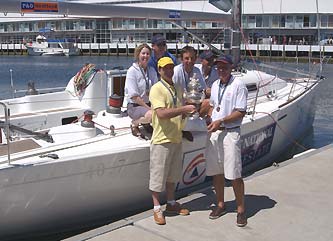 |
|
| space |
| Outside
Sydney's heads after the start, the two super maxis Skandia and Zana
sailed well out to sea while Grundig remained closer inshore. At an interview
in Hobart after arrival on December 29, Sean Langman, the Skipper of the
pocket maxi said "When we seen the two maxis head way out to sea there
was a bit of a panic, thinking there was another mark to round outside the
heads." |
| space |
| Previous
races with a huge fleet requiring two starting lines, two offshore marks
were used to equalise the race distance for starters from both lines. However
for the crew on Grundig after the first radio sked, unease quickly
switched to elation after discovery that they were now out in front of the
fleet. |
| space |
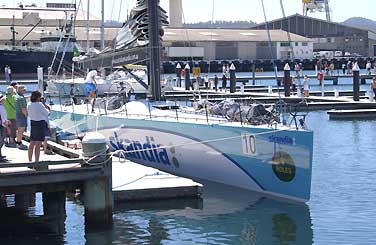 |
Line
Honours winner, Grant Warrington's Skandia.
|
|
| space |
| For most
of the first night Grundig had held the lead with a slightly more
favourable breeze inshore. But the following morning, the two super maxis
regained the lead in the same order as they had passed through the heads
and had maintained those positions for the remainder of the race. |
| space |
| This may
not have been the case if Grundig had not collided with a Sunfish
off Green Cape, causing damage to one of the boat's two rudders. With a
jury setup using the remaining rudder (useless on a starboard tack from
being out of the water) and new leak in the hull to contend with, the crew
battled on to clinch third over the line behind Skandia and Zana
in the early dawn of the day three. |
| space |
Third
over the line after New Zealand Maxi Zana and after an amazing effort
to get to Hobart after hitting a Sunfish, Grundig.
|
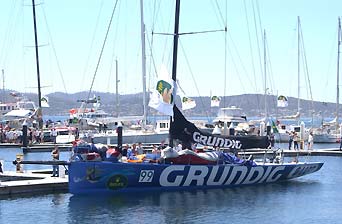 |
|
| space |
| Skandia
the line honours winner also collided with a Sunfish, completely stopping
the boat in her tracks. This time the canting keel was hit, but fortunately
the boat suffered no damage. |
| space |
| The same
can't be said however for Nicorette unfortunately. Over 30 hours
of beating into strong headwinds, the new canting keel supporting succumbed
to damage along with some internal non-structural hull damage. By midnight
on the 28th and with no sign of any change in the weather, Nicorette
relinquished forth position and turned back for Eden. |
| space |
Forth
over the line, Brindibella approaching the Battery Point finishing
line on the Derwent.
|
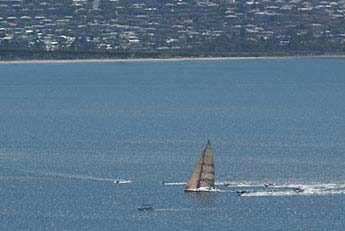 |
|
| space |
| The line
honours leaders of the fleet basically had the wind in their face all the
way down to Tasman Island. But the beat to wind continued on the other side
as they commenced their crossing of Storm Bay. |
| space |
| All the
way from Sydney, Zana had remained no more than a couple of miles
behind Skandia and was only a few hundred metres astern when both
entered Storm Bay. But after changing to a Code O head sail, Skandia
close hauled at 13 knots to cross the bay to gradually open the gap. In
a two and a half hour dash to the Iron Pot Lighthouse and the mouth of the
Derwent River, the gap was just over a nautical mile. |
| space |
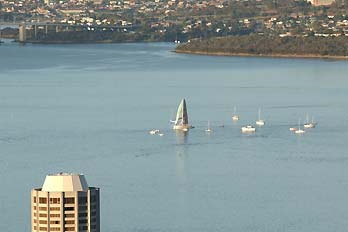 |
Cruelty
of the a Derwent calm, formular1sailing.com just waiting for
any puff to get over the line. When they did eventually got there,
only the bow of the boat crossed the line instead of the entire boat
as as required by the rules. As a result, Yendys , about 20
minutes behind when this shot was taken offically crossed the line
20 minutes ahead of formular1sailing.com.
|
|
| space |
| The beat
to windward continued up the Derwent for the line honours leaders with a
light north to north-west breeze rolling down valley. Skandia crossed
the line at 4:14am on the 29th of December and Zana, 14 minutes later
at 4:28. |
| space |
| After a
gutsy effort, Grundig was third over the line at 9:19 and Brindabella
at 10:30. |
| space |
formular1sailing.com,
still
waiting for that breese only metres from the line.
|
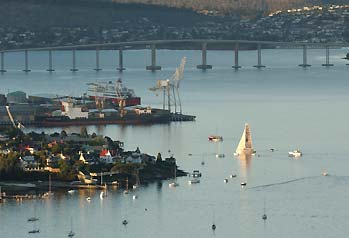 |
|
| space |
| Back out
in the Tasman and Bass Strait in the afternoon of the 28th, the leading
edge of a high pressure system had finally moved on out to sea taking its
strong south-westerlies with it. A 5:00pm press release revealed that many
within the bunch just east of Flinders Island, found themselves parking
and were making very little progress. |
| space |
| Eventually
with no influence from the high pressure system above, local weather patterns
kicked in to produce some onshore sea breeze. A crew member on formular1sailing.com,
said "The breeze ranged between 25 to 30 knots and provided a good
6 to 7 hours of great downwind sailing." According to Bill Lennon,
part owner of Fuzzy Logic, "It was sensational, the best downwind
sailing I have ever had." |
| space |
| By the
following morning after the leaders had docked, the sensational breeze became
a little too much for the rigging on Dysons Cobb & Co. At 8:30am
and on their 10th anniversary voyage of the boat's line honours win in the
treacherous 1993 race (as Ninety Seven), the mast came tumbling down
with 102 miles left to the finishing line. Fortunately no crew were hurt
in the event that happened while sailing under spinnaker in a 15 to 20 knot
north-west to north-east breeze. |
| space |
| After some
excellent downwind sailing down the east coast of Tasmania, some of the
contenders for a win on handicap found themselves becalmed near Tasman Island.
The eventual winner for both IMS and IRC Overall, First National Real
Estate, found themselves becalmed twice for a total of 1 hour and 40
minutes. The breeze that eventually got them over the line at 5:23am was
a light south-westerly of 8 to 10 knots. |
| space |
Yendys,
also had to contend with being becalmed on the Derwent.
|
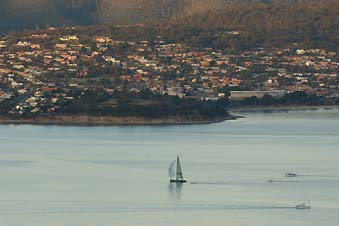 |
|
| space |
| space |
|
|









